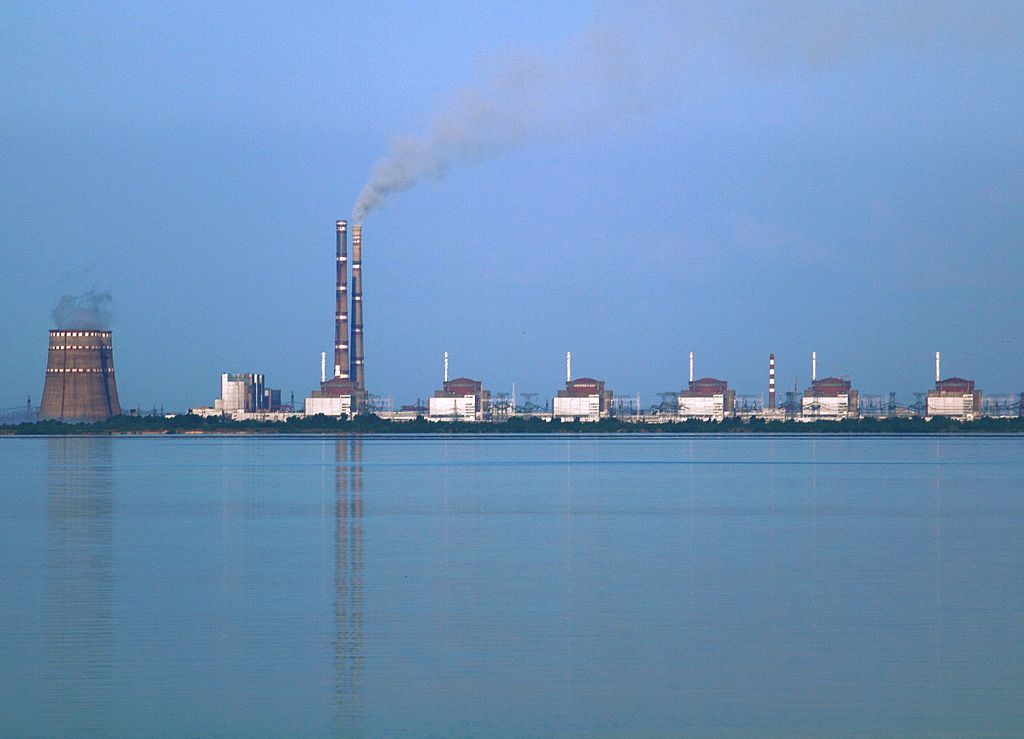Ukraine forges ahead with nuclear power
By Dawn Stover | July 4, 2022
 Zaporizhzhia nuclear power plant in southern Ukraine. The two tall smokestacks are at a coal-fired generating station about 3km beyond the nuclear plant. Photo credit: Ralf1969 via Wikimedia Commons.
Zaporizhzhia nuclear power plant in southern Ukraine. The two tall smokestacks are at a coal-fired generating station about 3km beyond the nuclear plant. Photo credit: Ralf1969 via Wikimedia Commons.
Russian forces are occupying Ukraine’s largest nuclear power plant. Low-flying Russian missiles have hurtled past another plant in southern Ukraine, and Russian shelling recently damaged buildings at a nuclear research institute in the Ukrainian city of Kharkiv.
Is Ukraine having second thoughts about nuclear energy? Recent developments suggest just the opposite.
Last month, Energoatom, Ukraine’s state-owned nuclear utility, signed agreements to build more reactors; transition to buying all its nuclear fuel from Sweden rather than Russia; and construct a new engineering and technical center focused on nuclear power. Energoatom also received approval to start storing its own spent nuclear fuel in a newly built centralized facility, although the facility can’t begin accepting nuclear materials until they can be safely transported by train.
An “untenable” situation? According to Ukraine, eight of its 15 nuclear reactors are currently connected to the grid, including two of the six reactors at the Zaporizhzhia Nuclear Power Station. Russian forces have occupied the Zaporizhzhia site since early March, but Russia told the International Atomic Energy Agency (IAEA) that Ukrainian operators continue to run the nuclear plant. However, the operators have at times been prevented from transmitting online data to the IAEA about the status of nuclear materials at the plant, and the Russians have reportedly been interrogating and harming plant employees suspected of resisting the unprecedented occupation. A few days ago, an alarming Facebook post by Energoatom warned that the Russian occupiers might try to frame Ukrainian workers by dropping explosives or weapons into the plant’s cooling water.
For nearly a month, IAEA Director General Rafael Mariano Grossi has been saying that an IAEA-led international mission to the Zaporizhzhia plant is urgently needed. Grossi has called the situation there “untenable” and warned that the occupation is delaying maintenance work, compromising the Ukrainian staff’s ability to make decisions, and increasing the risk of an accident or security breach.
Grossi initially said Ukraine had requested an expert mission, but Energoatom accused Grossi of “lying.” The Ukrainian operator said it did not want the IAEA to visit until Ukraine regained control of the site, because an official visit would legitimize the Russian occupation. Also, Energoatom questioned how a mission could safely reach the site.
Grossi has also expressed concerns about missiles flying close to another site, the South Ukraine Nuclear Power Plant. On June 5 and again on June 26, Energoatom reported that the plant’s surveillance cameras recorded video of a Russian cruise missile flying “critically low” over the plant. Ukraine previously reported a missile flying directly over the same site on April 16.
If a stray missile were to strike a reactor, containment structure, or fuel storage facility at one of Ukraine’s four operating nuclear power plants, it could lead to a nuclear accident.
Storing Ukraine’s spent fuel. Nuclear fuel remains highly radioactive long after it has been used to generate electricity. When spent fuel rod assemblies are first removed from a reactor core, they are stored in a pool. After a few years of submerged cooling, the rods can be moved into concrete dry casks that are air-cooled.
In the United States, that’s as far as the radioactive waste from commercial nuclear power plants has gone. But in Ukraine, Energoatom and Holtec International—a US-based company that makes casks, cranes, transporters, and other equipment for storing and transporting spent fuel—were putting the finishing touches on a Centralized Spent Fuel Storage Facility when the Russians invaded.
The new facility is an “interim” storage site where up to 458 casks filled with spent fuel from three of Ukraine’s four nuclear power plants—South Ukraine, Rivne, and Khmelnytsky—will be interred until a permanent underground repository can be created. (At the Zaporizhzhia plant, spent fuel will remain onsite in dry casks for the next 50 years.)
The storage facility, which is designed to last at least 100 years, is located about 14 kilometers from the Belarus border, within the Chernobyl Exclusion Zone. (Holtec wants to build a similar facility for consolidated interim storage of US nuclear waste in New Mexico.) Energoatom and Holtec have been collaborating on the storage facility since 2005, with construction beginning five years ago.
Last November, the two companies began preparing to transfer waste by conducting cold tests (without actual fuel) at the storage facility and the Rivne plant in northwestern Ukraine. A 43-kilometer spur built last year connects the storage facility to the nation’s rail system.
Energoatom expected to receive an operating license for the facility on March 5, and delivery of the first casks containing actual fuel in late April, but the Russian invasion delayed the license approval until April 25. The facility is now ready to start accepting spent fuel, but there’s another snag: a ban on transporting nuclear materials through Ukraine.
Any transport of radioactive waste carries some risks, but transporting nuclear material is especially risky in a war zone. Fuel-laden casks travel by train and could be struck by Russian missiles or artillery, intentionally or not. Storage casks do not have as much protection from high-velocity impacts as a reactor containment building.
In the past, Ukraine sent its spent fuel to Russia for reprocessing. One of the reasons for building the storage facility was so that Ukraine would no longer have to pay Russia’s state nuclear corporation Rosatom for expensive waste handling services. Energoatom hoped to save up to $200 million by operating its own facility.
New fuel supplier. Ukraine is also getting out of the business of buying nuclear fuel from Russia. On June 2, Energoatom signed a new agreement with the US-based Westinghouse Electric Company that will enable Ukraine’s nuclear power plants to get all their fuel from Sweden instead of Russia. (Earlier fuel contracts between Energoatom and Westinghouse, signed after Russia annexed Crimea in 2014, had already reduced Ukraine’s dependency on Russia.)
The fuel agreement was one of three agreements signed that day in the presence of Ukraine’s Minister of Energy, the Swedish Ambassador to Ukraine, the president of Energoatom, and the president of Westinghouse. A second agreement covers Energoatom’s intent to build nine new nuclear reactors designed by Westinghouse—which sells nuclear reactors as well as nuclear fuel—and the third agreement will create a Westinghouse Engineering and Technical Center in Ukraine.
Energoatom President Petro Kotin vowed that the company would “not only write a new chapter in the history of Ukraine’s nuclear energy but also make an important contribution to the energy independence of Europe.”
Energoatom had already planned to build five new Westinghouse AP1000 nuclear reactors—the same type of reactor currently under construction at the United States’ Vogtle nuclear plant in Georgia but plagued by delays and massive cost overruns. Two other AP1000 reactors that were under construction in South Carolina were terminated in 2017.
Energoatom plans to speed up construction of its first AP1000 by using reactor components that were built for the failed South Carolina project but not yet installed. The utility will also repurpose structures created for a Russian-designed reactor that was only 28 percent completed at Ukraine’s Khmelnytsky nuclear plant when construction halted in 1990.
To some experts, that looks like cutting corners. From Energoatom’s perspective, it’s the kind of ingenuity that has served Ukraine well in its war with Russia.
Together, we make the world safer.
The Bulletin elevates expert voices above the noise. But as an independent nonprofit organization, our operations depend on the support of readers like you. Help us continue to deliver quality journalism that holds leaders accountable. Your support of our work at any level is important. In return, we promise our coverage will be understandable, influential, vigilant, solution-oriented, and fair-minded. Together we can make a difference.
Keywords: AP1000, Ukraine, Zaporizhzhia nuclear power plant, interim storage, spent fuel
Topics: Nuclear Energy, Nuclear Waste















Isn’t it time we all see that neither nuclear reactors nor nuclear waste can be kept safe in a war zone? We now see that war zones can pop up anywhere. Isn’t it time that everybody who has been promoting nuclear power should see their mistake and become “anti-nuclear?”
Russia and Ukraine are united about one thing: that nuclear power is wonderful thing, and that the shelling and military occupation of a nuclear power plant is nothing to worry about. It is not even reported to the IAEA as an incident, for example as a defense-in-depth issue.
The IAEA is an accomplice to the two reckless governments in discrediting the integrity of the INES incident reporting system.
Of course the Russians are by far the most guilty party.
There is no doubt nuclear power can be safe. The French have shown that. They get about 90% of their electricity from pressurized water reactors. I read they also encapsulate the waste in glass and keep it in underground caves.
Whatever may be said of nuclear safety in France, that shows nothing about nuclear safety in Ukraine. The French got 69 percent, not 90 % of their electricity production from nuclear in 2021. It will be less in 2022. The French waste uranium from reprocessing — 96 per cent of the uranium fuel — is sent to Russia (according to French nuclear cycle company Orano p25). This may be because the French can’t or won’t handle contaminated uranium which also contains unwanted isotopes U-232 (gamma emitter) and U-236 (neutron poison during operation, complicates waste handling with increased amounts of Np-237.)… Read more »
Ukraine’s desire to demonstrate independence from Russia is understandable. But this seems like ‘cutting off its nose to spite its face.’ Completely phasing out nuclear plants seems like a more effective way to show it’s disdain.
Wall Street Journal today says the Zaporizhzhia nuclear power plant complex they’re occupying has been turned into a military base! Russia knows the Ukrainian army would not dare attack near this base.
Nuclear power is now a weapon of war.
https://www.wsj.com/articles/russian-army-turns-ukraines-largest-nuclear-plant-into-a-military-base-11657035694
Now will nuclear power apologists finally become anti-nuclear?